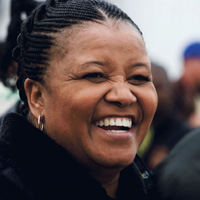The world of acid mine drainage is filled with myriad characters with competing interests. Follow this guide to see who’s who.
 The activists: The self-proclaimed “Erin Brockovich of South Africa”, Mariette Liefferink leads the pack of those sounding the acid mine drainage (AMD) alarm bells. Organisations like Liefferink’s Foundation for Sustainable Environment, Earthlife Africa and Greenpeace are teaming up with disgruntled scientists, concerned unions, and affected community members to push the government and industry to do something — and soon.
The activists: The self-proclaimed “Erin Brockovich of South Africa”, Mariette Liefferink leads the pack of those sounding the acid mine drainage (AMD) alarm bells. Organisations like Liefferink’s Foundation for Sustainable Environment, Earthlife Africa and Greenpeace are teaming up with disgruntled scientists, concerned unions, and affected community members to push the government and industry to do something — and soon.
 The mines: Simultaneously the bad guys and the poor suckers who are left to pick up the scraps of a fading gold industry, mining companies sit in a precarious place. While many have left tailings unremediated and voids to fill up, others are attempting to pump and treat what they can, but call on government to assist with enormous costs and historical liability.
The mines: Simultaneously the bad guys and the poor suckers who are left to pick up the scraps of a fading gold industry, mining companies sit in a precarious place. While many have left tailings unremediated and voids to fill up, others are attempting to pump and treat what they can, but call on government to assist with enormous costs and historical liability.
 The government: Due to the large number of ownerless and abandoned mines, the Department of Water Affairs and Department of Mineral Resources are responsible for a large part of the AMD debacle. Poor remediation and lack of action has been encouraged by a poorly regulated environment initiated under apartheid and further facilitated by lack of management, skills and budget under democratic governance.
The government: Due to the large number of ownerless and abandoned mines, the Department of Water Affairs and Department of Mineral Resources are responsible for a large part of the AMD debacle. Poor remediation and lack of action has been encouraged by a poorly regulated environment initiated under apartheid and further facilitated by lack of management, skills and budget under democratic governance.
 The scientists: Academics and scientists have been at the forefront of the AMD issue for decades, releasing reports on the affects of mine effluent since the 1950s. But their data doesn’t always align, and personal politics encouraged by funding allegiances puts many scientists head-to-head: who pays who is central to who says what. While all agree there’s a problem, opinions vary on the extent of the crisis, as well as how to fix it.
The scientists: Academics and scientists have been at the forefront of the AMD issue for decades, releasing reports on the affects of mine effluent since the 1950s. But their data doesn’t always align, and personal politics encouraged by funding allegiances puts many scientists head-to-head: who pays who is central to who says what. While all agree there’s a problem, opinions vary on the extent of the crisis, as well as how to fix it.
 The communities: From Soweto to Potchefstroom, from Emalahleni to Randfontein, millions of South Africans are living, working, playing, and praying amid mine waste. While many communities see tailings dumps and polluted water as just another fact of life, concern is starting to spread, with neighbours swapping stories of decreased crop yields, birth defects in livestock and increased cancer rates.
The communities: From Soweto to Potchefstroom, from Emalahleni to Randfontein, millions of South Africans are living, working, playing, and praying amid mine waste. While many communities see tailings dumps and polluted water as just another fact of life, concern is starting to spread, with neighbours swapping stories of decreased crop yields, birth defects in livestock and increased cancer rates.
This article made possible through funding from the Open Society Foundation for South Africa’s Media Fellowship Programme